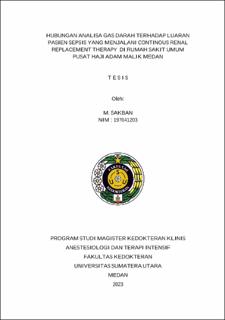| dc.description.abstract | Introduction Sepsis is a critical condition that most often causes increased mortality rates in intensive care due to multiorgan damage. For example, acute kidney injury (AKI) occurs in 40–50% of patients who experience sepsis in the ICU and of course will increase mortality in these patients. Establishing an early diagnosis of sepsis induced AKI will influence when is the right time to start intervention that is appropriate to the patient's condition, and this will greatly influence the reduction in the number of patients experiencing AKI in sepsis patients. Several epidemiological studies have mentioned a significant association between AKI and chronic kidney disease high mortality rate and expensive medical costs. Renal replacement therapy (CRRT) has been able to control uremic syndrome on patient with hemodynamics No stable, However up to These AKI patients with sepsis who undergo dialysis still have a high mortality rate, namely 60–80%.
Method This research is an analytical observational study with a retrospective cross-sectional design using secondary data from medical records with a sample size of 30 samples.to assess the relationship between AGDA and the outcomes of sepsis patients.
Results: In this study, it was found that 100% of patients who underwent CRRT died. And in this study there is a significance difference in blood gas analysis before and after CRRT. In this study there is no significant difference in blood gas analysis in patient after CRRT.
Conclusion In this study, no relationship was found with the outcomes of sepsis patients undergoing CRRT | en_US |



